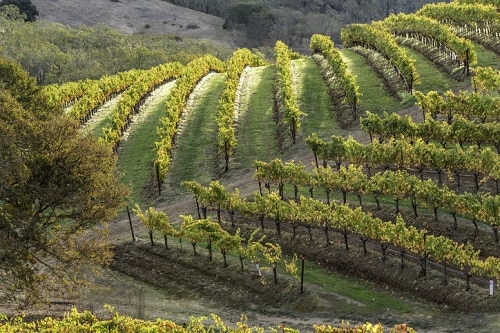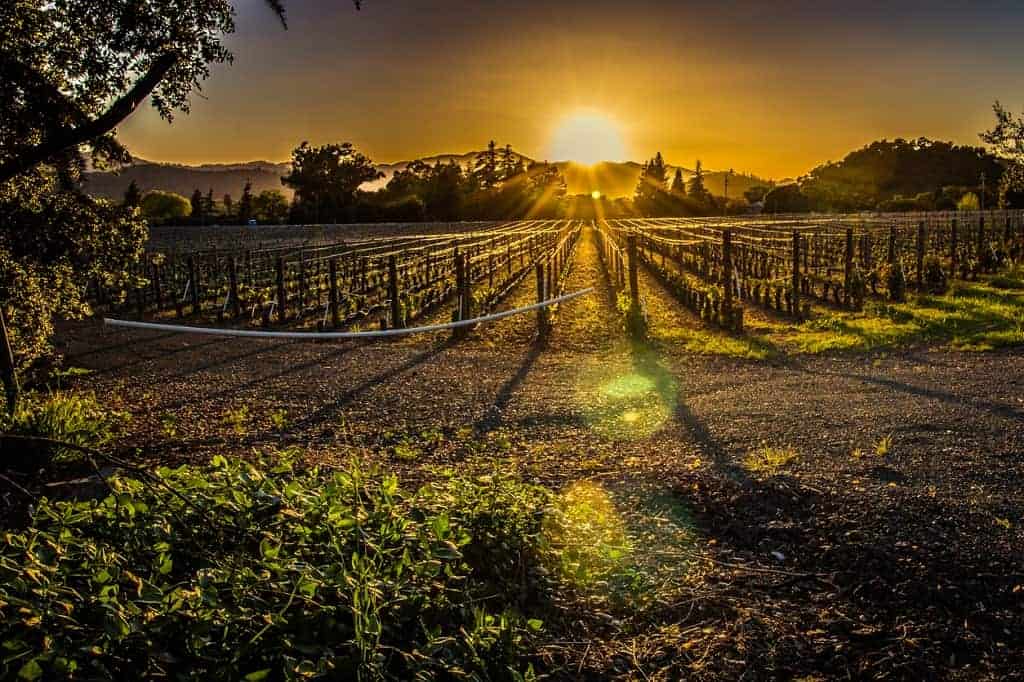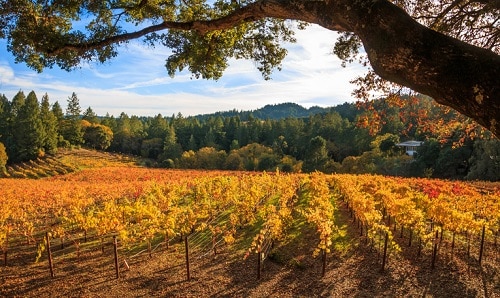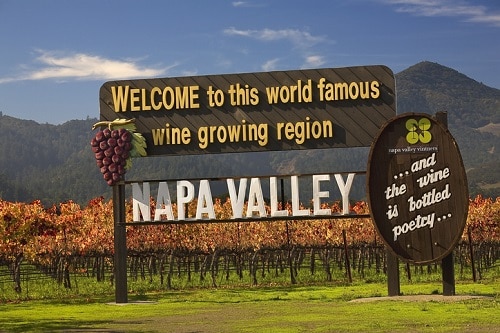Discover Napa Valley
Last Updated on May 4, 2023.
Napa Valley is the most important wine region in the United States. While experts and enthusiasts can debate which regions are “best,” the importance of Napa Valley’s wines cannot be underestimated. It was the first American wine region to be internationally recognized for producing high quality wines that stood toe-to-toe against its French counterparts, which helped give American wines an international platform.
There is also little doubt that the “Napa Cab” style is immediately recognizable and is often imitated around the world – an impressive feat for a comparatively young wine region that does not have centuries of winemaking tradition to follow! Napa Valley wines have become an integral part of California’s robust economy that reaches far beyond basic production.
The History of Napa Valley
Napa Valley is north and east of San Francisco, running about 30 miles long and only about 5 miles wide. Flanked by the Vaca Mountains to the east and the Mayacamas to the west, it was formed by volcanic and earthquake activity, much like most of California’s rugged terrain.
Its location allows Napa Valley to enjoy a Mediterranean climate, with warm dry summers and cool rainy winters. Combined with its unique patchwork of soils, its unique terroir enabled early European settlers to see that wine grapes thrived there.
George Yount, namesake of today’s Yountville, is credited with first having planted grapes in the late 1830s. Other settlers soon followed suit and the potential for commercial wine production was realized. By 1861, Charles Krug opened the first commercial winery and within 30 years, there were close to 150 commercial wineries throughout the Napa Valley.
Early success, however, was quickly met with adversity. Napa did not escape the global phylloxera plague, and by the end of the 19th century, the majority of Napa vines were devastated by the louse. Before wineries had adequate time to fully recover, the Volstead Act was passed and proved to be the final nail in the coffin for many commercial wineries.
A few were able to maintain operations with under-the-radar production, and investors were quick to move in when when Prohibition ended. By the mid 1940s, Napa production increased steadily and the subsequent decades saw now-legendary names come in and build empires that spearheaded the high quality that we know today.
Despite thriving local business, Napa wines struggled to gain deserved international attention. That all changed in 1976 with the now-infamous “Judgment of Paris.” British merchant Steven Spurrier organized a blind-tasting competition between famous French wines and their Californian counterparts. Top Bordeaux were tasted blindly with Napa Cabs, and white Burgundies with California Chardonnays. And, although almost all judges were French, Chateau Montelena’s Chardonnay and Stag’s Leap Wine Cellars’ Cabernet Sauvignon took the top spots.
Today, Napa is king of American wine regions and its wines stand shoulder-to-shoulder with some of the finest Bordeaux and Burgundies. Innovative winemakers have also started experimenting with a wider variety of grapes, which will likely change global perception of what Napa can grow. Napa is committed to pursuing excellence for decades to come.
RELATED: The Best Napa Valley Wineries to Visit This Year
Napa Valley Grape Varieties
The question in Napa, really, is what doesn’t grow? Just about any varietal does well here, understanding that micro-climates do vary quite a bit. Everything from Riesling to Zinfandel is cultivated, but the following are the most commonly found:
Cabernet Sauvignon
Cab dominates Napa Valley, making up 40% of all plantings. It absolutely thrives here and is used to produce robust, tannic, and fruit-forward wines. While most are meant to age for a while, the fruit allows them to be enjoyed much earlier than their Bordelais counterparts.
Chardonnay
Chardonnay and Cab aren’t usually bedfellows since they thrive in difference climates, but Chardonnay has proved to do remarkably well in different sub-AVAs around Napa. In particular, it flourishes in Carneros, that cooler area that straddles both Napa and Sonoma. There, it is often used for Sparkling Wines as well and is part of the traditional Champagne-style Chardonnay-Pinot Noir blend.
Pinot Noir
Similar to Chardonnay, Pinot needs slightly cooler conditions than Cab but it loves the Carneros AVA. Expect heartier versions compared to Burgundies, with deep color, bolder fruit, and a richer mouthfeel.
Merlot
Thankfully, Merlot is making a comeback! This formally heralded grape suffered the “Sideways Effect” after the film but was still grown throughout Napa for single-varietal bottlings as well as for blends. After nabbing Wine Spectator’s top wine in 2017, we have seen more returning to popular consumption.
Sauvignon Blanc
Much like its Bordeaux brethren Cab and Merlot, Sauvignon Blanc really, really likes Napa Valley. Stylistically, Napa Sauv Blancs tend to fall between Bordeaux and New Zealand: fewer grassy green notes, but more white florals with zesty citrus.
Napa Valley Sub-AVAs
From the south end of Napa Valley, the first sub-AVA is Carneros, which straddles over to Sonoma Valley as well. Moving north from there are Oak Knoll, Yountville and Stag’s Leap District, Oakville, Rutherford (famous for its “Rutherford dust” soil), St. Helena, and finally Calistoga. Cabernet does well throughout this run. Pinot Noir thrives in Carneros and Oak Knoll because both experience a cooling influence from San Pablo Bay, and Zinfandel loves the heat of Calistoga.
Just to the west of the main drag, you’ll find the Mount Veeder AVA and the Spring Mountain and Diamond Mountain Districts. Cab, Merlot, and Zin all love it in these areas with some of the most-valued Cabs grown in Spring Mountain.
To the east of Calistoga is Howell Mountain, home to some legendary Cabernets.
Atlas Peak is to the east of Stag’s Leap District, and both Merlot and Cab do well here.
Finally, the lesser-known AVAs of Chiles Valley, Coombsville and Wild Horse Valley are slightly further afield. Chiles Valley is east of Lake Hennessey, and Pinot Noir does well there. Coombsville is just east of Napa city itself, up against Solano County. Wild Horse Valley is mostly in Solano, but bits overlap to Napa.
Napa Valley Wines to Try Available Nationally
There is no shortage of Napa Valley wines available around the United States. Among the most popular labels are Duckhorn, Mondavi, Caymus, Cakebread, and Rombauer, but the options are almost limitless. Despite some wines commanding top dollar, there are plenty of affordable options, so work with a trusted wine merchant to find those that best fit your palate and budget.
You can take a look at some of our favorite wineries and partners within Napa below.
Written By Jamie Metzgar
Jamie Elizabeth Metzgar began her career in wine by pouring in a tasting room on the East End of Long Island, NY. After moving to New York City, she landed a position at Chambers Street Wines where she was encouraged to pursue wine education at the Wine & Spirits Education Trust (WSET). She earned Level III certification there and has since earned California Wine Appellation Specialist and Certified Specialist of Wine certifications as well. After way too many moves, she is now in the Central Coast of California where she is compiling an unofficial roster of dog-friendly tasting rooms.



